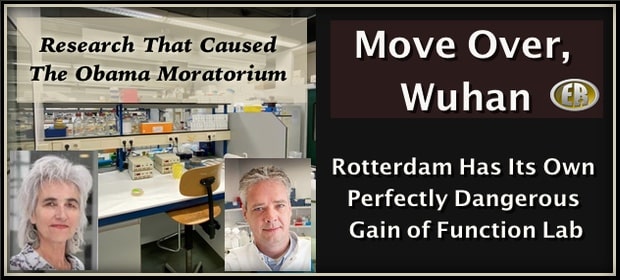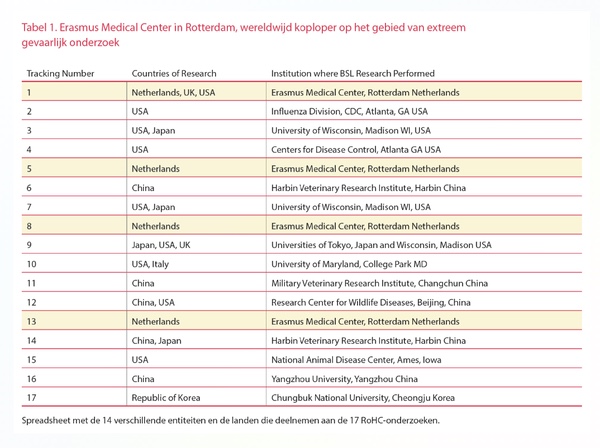
ER Editor: Many thanks to Dutch journalist Michel van der Kemp for bringing this topic to our attention and writing the introduction below. Here are some links regarding Dr. Marion Koopmans of the Viroscience Lab at the Erasmus Medical Centre in Rotterdam (see featured image): World Economic Forum (she is quoted under point no.3); inclusion in the WHO Scientific Advisory Group; spreading fear on behalf of the Dutch Research Council (with the ominous abbreviation ‘NWO’) about a highly improbable Dutch pandemic caused by mosquitoes.
Her colleague, Ron Fouchier, was responsible for souping up (aka ‘gain of function’ research) biological material from ferrets that produced a transmissible bird flu BETWEEN HUMANS, which was deadly in 60% of infections. That prompted Obama to enact a moratorium on gain of function research in 2014, a moratorium that was lifted in 2017. Fouchier did that when the Rotterdam lab had BSL3 status. Now it’s been ‘promoted’ to BSL3+. Wuhan is a BSL4 lab.
********
Introduction by Michel van der Kemp
The Viroscience Lab of the Erasmus Medical Center in Rotterdam is much more dangerous than we have been led to believe, and safety supervision is completely lacking. That is the conclusion of the article below, which was published in De Andere Krant. As the article shows, deputy director Professor Ron Fouchier lied to the Rotterdam city council when he said the chances of a virus escaping only happens once every billion years. The Viroscience lab appears to be the global leader in the field of extremely dangerous flu virus research. What could go wrong in the middle of a big European city?
The head of this lab, Prof. Dr. Marion Koopmans, is making headlines of her own. Koopmans is best-known for being co-author of the Corman-Drosten paper, a paper that validated the RT-PCR test for the testing of SARS-CoV-2, after which the test became the driving factor of the 2020 Covid-19 pandemic.
Koopmans has her deep state tentacles everywhere. When she took up office as a member of the Outbreak Management Team Netherlands (through which she advises the Dutch government on the Corona restrictions) in 2020, she listed no fewer than 21 additional positions in her declaration of interests. However, this was no reason to believe that there could be a conflict of interest. Even when she became a member of the international research team (Scientific Advisory Group for the Origins of Novel Pathogens (SAGO)) that investigated the origin of the virus in Wuhan, this was not suspected. But when The National Pulse published an article about her ties to the Chinese Communist Party (CCP), she was kicked out of the research team. Koopmans is still responsible for safe-guarding the Viroscience lab, however.
For her contribution to the Corman-Drosten paper, she will have to appear in a Dutch court on July 27th 2022. Koopmans was on record as early as June 2020 saying that the PCR-test could not detect illness. But the Dutch court will probably find a renewed way to protect the swamp. Plaintiffs in the case want all corona measures to be declared null and void with retroactive effect.
********
Chance of virus disaster Rotterdam real, supervision is missing
The chance of a life-threatening virus escaping from the Viroscience lab of Erasmus MC in Rotterdam is real and many times greater than claimed by Viroscience. So say leading international experts, including Professor Marc Lipsitch, a Harvard University epidemiologist, and Dr Lynn Klotz (ex-Harvard). Research by Klotz also shows that Rotterdam is a global leader in life-threatening virus experiments. Many scientists argue that the benefits of such research are questionable and disproportionate to the risks.
BOET SCHOUWINK and KAREL BECKMAN
Professor Ron Fouchier, deputy director of Viroscience behind Marion Koopmans, told the Rotterdam city council on June 24, 2021 that the chance of a dangerous virus outbreak in the Rotterdam lab would be only “one in a billion years”. But Lynn Klotz, senior scientist at the Center for Arms Control and Non-Proliferation in the US, calls that claim “highly unlikely” as “undetected infections are a regular occurrence. There is even a scientific term for it: UULAI, or ‘undetected or unreported laboratory-acquired infections’”.
Renowned epidemiologist Marc Lipsitch of Harvard University also believes that the risk of a ‘lab leak’ is much greater than Fouchier claims. Viroscience, which opened a new high-risk biolab in Rotterdam in 2018, developed an extremely contagious variant of a life-threatening bird flu virus in 2011. This led to worldwide commotion. The then-minister Edith Schippers promised the House of Representatives to create regulations for the safety of biolabs. However, when asked, RIVM (ER: National Institute for Public Health and the Environment) and the Netherlands Institute for Public Safety (NIPV), which works for the security regions, acknowledge that hardly anything has happened since then. There is still no national regulation, and “no official supervisor has yet been appointed”, according to the RIVM. “Responsibility lies with the lab itself.”
Worldwide commotion
The debate in the municipal council was requested by councilor Ellen Verkoelen of 50+ (ER: a Dutch political party), who was alarmed by the article ‘Frankenstein in the Polder’ by Boet Schouwink and Maaike van Charante from May 2021. This describes, among other things, how Fouchier in 2011, experimenting with ferrets, had developed the most dangerous virus in history: a barely transmissible bird flu virus, which is fatal in 60 percent of cases, was made transmissible between humans. (van der Kemp: Fouchier bragged in 2011 about how he “probably created one of the most dangerous viruses ever.” Subsequently, Time Magazine placed him in the top 100 of Most Influential People in 2012.) This caused a worldwide commotion at the time. President Obama imposed a moratorium on such so-called gain of function research in response to Fouchier’s bird flu virus – research in which viruses are deliberately made more dangerous.
Edith Schippers, the then Minister of Infrastructure and Water Management, sent two letters to the House of Representatives on 12 February and 7 March 2012 in response to questions from concerned MPs. She stated that laboratories such as Viroscience “meet strict requirements in the field of biosafety”, but also had to acknowledge that “there is no legislation in the Netherlands regarding the protection of highly pathogenic substances”. She also indicated that “the requirements with regard to biosafety and security that must be imposed on further research must be critically reviewed in the short term.”
Little or nothing has been done with this recommendation to date. In March 2020, the Institute for Physical Safety (IFV) in Arnhem, which conducts research for the security regions in the Netherlands, released a damning report on the safety of biolabs in the Netherlands. The IFV reported that there is still “no integrated legislation and regulations” for the safety of high-risk laboratories, that the location of the layout and the characteristics of the building … and the environment are not taken into account when granting permits”, that the legislation “does not provide for assessment of effects on public health and safety”, that there are gaps with regard to the assessment “on the manageability of disasters”, that there is no legal framework for the assessment of ‘bio-security’ (for example, the danger of a terrorist act), and that the security regions “are not automatically (timely) aware of the presence, exact locations and other relevant data of high-risk laboratories.” These alarming findings also hardly led to action (see box “Safety regions: no view of high-risk biolabs”).
The licensing of the high-risk laboratory that Viroscience opened in Rotterdam in 2018 took place on the basis of a temporary ‘assessment framework’ that had been specially developed for this purpose by the Rijnmond-Rotterdam safety region, “in anticipation of additional national legislation and regulations”, which still don’t exist. In this laboratory, the much-criticized research into H5N1 viruses, which was interrupted in 2014, was restarted in 2019.
Mayor Aboutaleb acknowledged during the committee meeting on June 24, 2021 that he was “very surprised” when he discovered that there are no additional requirements for the building permit for high-risk biolabs and also expressed his concerns about this to the Ministry of Education, Culture and Science. However, Fouchier swore in front of the mayor and councilors that there was no reason to worry. When asked “What is the probability that a virus, such as the one that caused a stir worldwide in 2012, could escape from a Viroscience lab?” he replied: “By my calculations, once every one billion years”.
Strong criticism
Fouchier’s answer didn’t come out of the blue. He published his “1 in a billion years” calculation in a scientific journal as early as 2015, in defense of his experiments. What he didn’t tell the mayor and councilors was that that calculation immediately drew strong criticism, including from renowned epidemiologist Professor Marc Lipsitch of Harvard University, who came to completely different findings in an article published in MBio, the journal of the American Society for Microbiology. Roughly speaking, Lipsitch establishes, based on empirical data, that an infection of a lab worker with a dangerous virus occurs once every 500 years in a BSL3 lab. He estimates that the chance that such an infection will subsequently develop into a pandemic is 15 percent. This is based on, among other things, an extensive scientific article from 2013, focusing on the situation at Viroscience (see box “The risk of a lab leak and the possible consequences”).
According to Lipsitch, Fouchier bases his calculations on the theoretical infallibility of the various layers of security surrounding the study. However, he does not take into account a number of complicating factors, says Lipsitch. First, he assumes that when an incident occurs, it is automatically noticed by an employee. But it is certainly possible that an incident occurs that is not identified by the employee concerned, and therefore does not lead to follow-up steps that could eliminate the potential contamination. Or that an incident is not reported at all.
Second, Fouchier does not take into account a deliberately caused incident. For example, by an employee with suicidal tendencies who wants to take as many people as possible with him in his death, or by an employee who has infiltrated the organization with a terrorist motive. Third, he ignores external factors such as natural or other disasters (such as an airplane impact) that could burn or submerge the Viroscience building. After all, Viroscience is not equipped with a massive concrete dome that can reduce the effect of such disasters, like a nuclear power plant or a nuclear weapons warehouse, for example.
Incidents
Fouchier’s “once in a billion years” theory, according to Lipsitch and other critics, is also at odds with the high number of incidents that have taken place in biolabs, including “western” biolabs, over the past decades. In the United States, more than 450 ‘accidents’ were reported in biolabs in the period 2015-2019, American investigative journalist Alison Young discovered on the basis of a FOI request with the American government. This included “leaks” of deadly bacteria and viruses, Young writes: “Lab accidents are not rare”.
In their 2021 book Viral, researchers Alina Chan and Matt Ridley cite the annual report of the US Federal Select Agent Program, which reports 219 “accidental escapes” and 13 cases of “lost samples.” This includes “dangerous pathogens such as anthrax, Ebola, deadly variants of bird flu and SARS coronavirus”. They also describe two separate cases in 2004 where two researchers became infected with a SARS coronavirus and infected others in their environment without realizing it. In both cases, a disaster could have been prevented by prompt intervention by the authorities.
Frontrunner
The lab accidents that have occurred so far involved viruses that were not extremely dangerous. If an incident takes place in Rotterdam, it could be very different. The investigations that take place at Viroscience are among the most dangerous in the world. That doesn’t just apply to Fouchier’s controversial 2011 bird flu program. Lynn Klotz published a 2019 overview of the 17 most dangerous flu virus investigations that took place in the world during the period 2011-2018. She did this on the basis of official scientific publications. The results make clear what position Viroscience occupies internationally: Erasmus appears to be the global leader in the field of extremely dangerous influenza virus research (see Table 1).
It’s the only lab that appears four times in Klotz’s list. The four extremely risky studies in Rotterdam that Klotz refers to were published in 2012, 2013, 2014 and 2017.
The gain of function research being conducted in Rotterdam is justified by the researchers as the only way to find out how and under what conditions a virus can develop into a deadly variant in nature. This would make it possible to develop vaccines (ER: of course it would!) now to combat variants that could emerge in the future, Fouchier told the council meeting. He was highly praised for this reason by the councilors.
But there is a lot to be said about the usefulness of gain of function research. Firstly, there are many possibilities of using other research methods with much less risk that yield at least as much information. Lipsitch lists nine alternative, “ethical” research methods in a 2014 article. These have the advantage that no laboratory animals are required, as is the case with Viroscience, which uses the largest number of laboratory animals of all research institutes in the Netherlands. Second, there is no unequivocal evidence that gain of function research has ever led to life-saving applications. However, the research does have an important downside: the viruses that are being developed can also be used as bioweapons. It is not for nothing that the gain of function research is called Dual Use research, because it can be used for both positive and negative (for example, military) purposes.

Military funding
This is not a theoretical possibility. The 2011/2012 H5N1 study that rocked the scientific community was sponsored by the US National Institutes of Health (NIH), which has come under heavy fire for its financial support of the Pentagon-funded Ecohealth Alliance, a private research institution with which Viroscience has close ties.
The Ecohealth Alliance has been discredited for its longstanding involvement in gain of function research into bat viruses in Wuhan, which continued during the US-imposed moratorium (2014-2017). Scientists do not rule out the possibility that the SARS-COV-2 virus accidentally escaped from the Wuhan lab. The Wuhan Institute of Virology has a higher safety level (Biosafety-Level 4) than Viroscience (BSL-3+). Marion Koopmans, director of Viroscience, took part in a fact-finding mission to Wuhan last year, together with Peter Daszak, director of the Ecohealth Alliance, to investigate the lab-leak theory surrounding SARS-COV-2. They concluded that SARS-COV-2 most likely has a natural cause, but that conclusion is controversial. No natural source for the virus has been found so far. The fact that Viroscience and the Ecohealth Alliance are closely intertwined is apparent from the fact that the list of ‘collaborators’ (cooperating organisations) on the Viroscience website includes four Dutch partnerships, but only one foreign party: Ecohealth Alliance. Exchange of research projects, at Ecohealth partly financed with military money, and thus serving a military purpose, is therefore obvious.
For many scientists, the great risks and unclear benefits of gain of function research are reason enough to demand a worldwide ban. Lipsitch founded the Cambridge Working Group in 2014, a group of now more than 300 scientists who argue for the abolition of gain of function research. Professor Richard Ebright, one of the world’s foremost microbiologists, said of Fouchier’s 2011 research: “This research should not have been done”. Followed by: “It will inevitably escape, and within a decade”.
RIVM: “No national legislation for biosecurity”
Biosecurity (the risk of deliberate undermining of safety) is monitored in the Netherlands by the Biosecurity Office of the RIVM. Little has happened in this area either since Edith Schippers’ letters to parliament in 2012, in which the minister indicated that national legislation should be introduced. “National legislation for biosecurity and dual-use research is being prepared,” a spokesperson for the RIVM reported when asked. He further states:
“Bureau Biosecurity does not have a list of all high-risk laboratories. Permits for such labs are issued via the environmental law and this data may be obtained from the relevant municipalities or the environmental service.”
When asked who supervises biosecurity at Viroscience and other labs, RIVM says:
“As national legislation for biosecurity and dual-use research is currently being prepared, no official supervisor has yet been appointed. However, biosecurity is closely linked to biosafety. Supervision in the field of biosafety, in particular GMO regulations, is carried out by the Human Environment and Transport Inspectorate (ILT), which also indirectly includes biosecurity aspects”.
To the question “Is the Biosecurity Office aware that Viroscience is conducting gain of function research?”, RIVM answers: “No”. According to the Biosecurity Office, the ‘primary responsibility’ for biosecurity is the responsibility of the lab itself.
Safety regions: no insight into high-risk biolabs
In March 2020, the Institute for Physical Safety (IFV), now the Dutch Institute for Public Safety (NIPV), which conducts research for the security regions in the Netherlands, published a damning report on the safety of biolabs in the Netherlands (see the accompanying article). What has happened since then? Not much. When asked, a spokesperson for the NIPV reports:
“The report was sent to the Security Council in September 2019 and a bill on this has now been consulted, which was at the end of 2021. This bill solves most of the problem of the security regions: high-risk biological laboratories can no longer establish themselves in a security region without the security region being aware of this”.
However, the spokesperson adds:
“We do not have an overview from the NIPV of which high-risk biolabs there are in the Netherlands and what activities take place there. There is also no national overview available, at least there was not in 2019. The NCTV (National Coordinator for Security and Counterterrorism) may have this overview. I cannot answer the question of how big the risks are from biolabs at the moment and what would have to be done to address them, because that was not part of the NIPV research, we cannot assess that”.
The security region is therefore now informed about the arrival of a biolab, but has no further involvement. Permits are granted on the basis of an environmental permit, states NIPV.
The chance of a lab leak and the possible consequences
In the insurance world, the risk to be borne is calculated as the product of the probability of a certain event and the costs of such an event. In this way an insurer can calculate a realistic premium for the coverage of a specific risk. Marc Lipsitch, one of the world’s leading epidemiologists, published a calculation in 2015 that indicated what the gain-of-function research into bird flu viruses, such as that carried out at Viroscience, could ‘cost’ annually. In the event of a pandemic, the cost is the number of lives lost. This can be calculated with the following parameters:
• Historically, between 24 and 38% of the world’s population has been affected by infectious influenza after an outbreak before it can be contained.
• The death rate (‘infection fatality rate’) of an H5N1 bird flu virus is between 1% (most mild form after mutations) and 60% (original form).
Lipsitch calculated a minimum and maximum probability. If we take the average of his calculation, we arrive at the following result. The infection rate (24-38= avg. 31%) multiplied by the world population (7 billion) and an IFR of 30 (1-60= avg. 30%) results in: 0.31*7*109*0.30 = 651 million dead. That is the ‘risk’ of H5N1 research. To determine the probability of an H5N1 virus escaping from a lab, Lipsitch looked at the frequency of infections due to lab leaks from BSL3 labs (such as Viroscience). He identified 4 (reported) infections during 2,044 observed lab years. This translates into a chance of an infection per lab year of 0.2%, or 1 infection incident per 500 years of lab research.
To calculate the probability that such an infection will lead to a pandemic, Lipsitch refers to a 2013 article, which is based on the situation at Viroscience and the demographic and geographic situation in Rotterdam and the Netherlands. The chance calculated in that article of an outbreak as a result of an infection at Viroscience is between 10 and 20%, so an average of 15%. In other words, the chance that an infection with a virus at Viroscience will lead to a pandemic is 15%. There is therefore a 0.2% chance of an infection per BSL3 study year, which leads to a pandemic in 15% of cases, resulting in 651 million deaths. That amounts to 195,300 effective deaths per BSL3 study year. (0.002*0.15*651 million) An insurance company that would have to take out insurance for the gain-of-function study would therefore have to assume a permanent risk of 195,300 deaths per year that BSL3 research is done. The security level of Viroscience is now slightly higher (now BSL3+) so that will have an influence. But the order of magnitude will still be of an equally alarmingly high level.
************
SOURCE

••••
The Liberty Beacon Project is now expanding at a near exponential rate, and for this we are grateful and excited! But we must also be practical. For 7 years we have not asked for any donations, and have built this project with our own funds as we grew. We are now experiencing ever increasing growing pains due to the large number of websites and projects we represent. So we have just installed donation buttons on our websites and ask that you consider this when you visit them. Nothing is too small. We thank you for all your support and your considerations … (TLB)
••••
Comment Policy: As a privately owned web site, we reserve the right to remove comments that contain spam, advertising, vulgarity, threats of violence, racism, or personal/abusive attacks on other users. This also applies to trolling, the use of more than one alias, or just intentional mischief. Enforcement of this policy is at the discretion of this websites administrators. Repeat offenders may be blocked or permanently banned without prior warning.
••••
Disclaimer: TLB websites contain copyrighted material the use of which has not always been specifically authorized by the copyright owner. We are making such material available to our readers under the provisions of “fair use” in an effort to advance a better understanding of political, health, economic and social issues. The material on this site is distributed without profit to those who have expressed a prior interest in receiving it for research and educational purposes. If you wish to use copyrighted material for purposes other than “fair use” you must request permission from the copyright owner.
••••
Disclaimer: The information and opinions shared are for informational purposes only including, but not limited to, text, graphics, images and other material are not intended as medical advice or instruction. Nothing mentioned is intended to be a substitute for professional medical advice, diagnosis or treatment.




